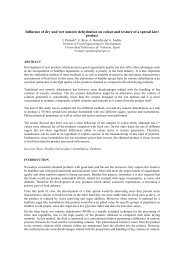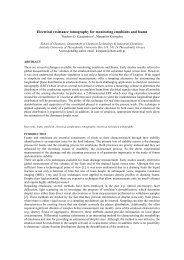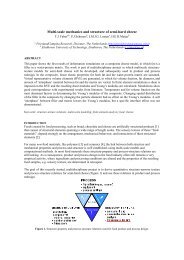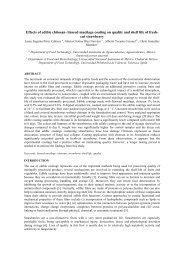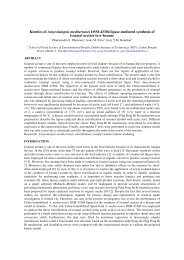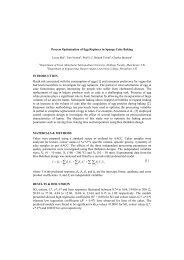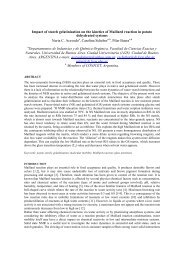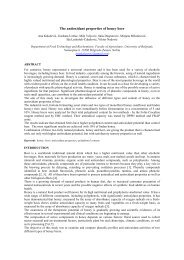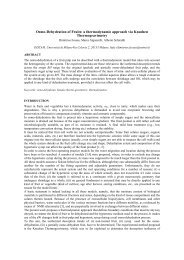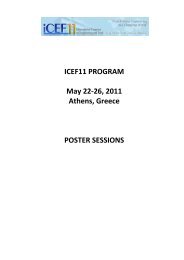Removability of bacterial spores from solid surfaces during cleaning
Removability of bacterial spores from solid surfaces during cleaning
Removability of bacterial spores from solid surfaces during cleaning
You also want an ePaper? Increase the reach of your titles
YUMPU automatically turns print PDFs into web optimized ePapers that Google loves.
insing (hereafter referred to as residual fraction). The residual fraction <strong>of</strong> <strong>spores</strong> adhered under the humid<br />
environment was below 0.3 irrespective <strong>of</strong> rinsing temperature for the both types <strong>of</strong> surface. In contrast, the<br />
residual fraction <strong>of</strong> <strong>spores</strong> adhered under the dry environment was around one; no removal by water rinsing<br />
was suggested for the both types <strong>of</strong> surface irrespective <strong>of</strong> rinsing temperature. Thus exposure to the dry<br />
environment <strong>during</strong> adhesion, or removing water around <strong>spores</strong> by evaporation, not only increased the<br />
number <strong>of</strong> adherent spore but also made the spore adhesion firm enough to endure shear force applied in the<br />
water rinsing. These results also showed that rinsing temperature had little effect on the removability <strong>of</strong><br />
<strong>spores</strong> <strong>during</strong> water rinsing.<br />
Hydrophobic interaction has been suggested as responsible for a wide range <strong>of</strong> spore adhesion [2]. Thus, if<br />
the <strong>surfaces</strong> have portions <strong>of</strong> hydrophobic nature, <strong>spores</strong> can strongly interact with those portions upon<br />
removal <strong>of</strong> water molecules covered them. Such interaction induced by drying may be a major cause for no<br />
removal in water rinsing even with shear force application, though further study is necessary for clarification.<br />
Figure 2. Residual fraction <strong>of</strong> B. subtilis <strong>spores</strong> on SS and PP coupons after water rinsing.<br />
Each coupon was contaminated with spore suspension and exposed to humid or dry environment for 60 min prior to<br />
water rinsing conducted with agitation for 10 min at (a) 25˚C or (b) 75˚C. Bars show standard deviation (n=3).<br />
Effect <strong>of</strong> alkali treatment on residual fraction <strong>of</strong> <strong>spores</strong><br />
Contaminated SS and PP coupons exposed to dry environments for 60 min were subjected to alkali treatment<br />
in 0.2% or 1.0% NaOH with agitation. Table 1 shows residual fractions <strong>of</strong> B. subtilis <strong>spores</strong> after 10 min<br />
alkali treatment. Generally the residual fraction was lower at higher temperature and at higher NaOH<br />
concentration for both types <strong>of</strong> <strong>spores</strong>. In this case, the decrease in residual fraction may be not only due to<br />
removal but also due to inactivation <strong>of</strong> <strong>spores</strong> by alkali. Therefore survival <strong>of</strong> <strong>spores</strong> suspended in 0.2% or<br />
1.0% NaOH for 10 min was studied for comparison. The results are also shown in Table 1. After alkali<br />
treatment at 25˚C, the residual fraction <strong>of</strong> <strong>spores</strong> on both types <strong>of</strong> surface was significantly higher than the<br />
survival fraction in suspension. This indicates at least that <strong>spores</strong> adhering to SS and PP <strong>surfaces</strong> had a higher<br />
tolerance to alkali than <strong>spores</strong> in suspension. After alkali treatment at 75˚C, the residual fraction <strong>of</strong> <strong>spores</strong> on<br />
PP surface was much higher than the survival fraction in suspension, though that <strong>of</strong> <strong>spores</strong> on SS surface was<br />
similar to the survival fraction. Thus the <strong>spores</strong> adhering to PP surface had significantly high tolerance to<br />
alkali.<br />
In general, bacteria in bi<strong>of</strong>ilm are known to show higher tolerance to environmental stresses, including<br />
chemical ones, than planctonic cells [3–5]. Bacteria can be protected <strong>from</strong> chemical stresses by the bi<strong>of</strong>ilm<br />
surrounding them. In the case <strong>of</strong> this study, however, the <strong>spores</strong> were adherent to the <strong>surfaces</strong> without any<br />
protective substances to cover them. Although mechanism for enhanced alkali tolerance <strong>of</strong> adherent <strong>spores</strong> is<br />
unclear at present, hydroxyl ions might hardly reach the surface because <strong>of</strong> chemical characteristics <strong>of</strong><br />
<strong>surfaces</strong>.<br />
Furthermore, apparent removal kinetics <strong>during</strong> alkali <strong>cleaning</strong> was investigated. Figure 3 shows the change in<br />
residual fraction <strong>of</strong> B. subtilis <strong>spores</strong> on SS and PP coupons <strong>during</strong> alkali <strong>cleaning</strong> with 1% NaOH at 65°C.



